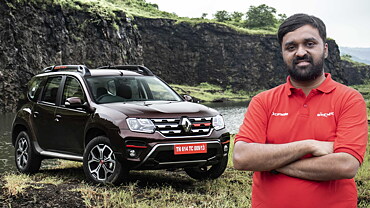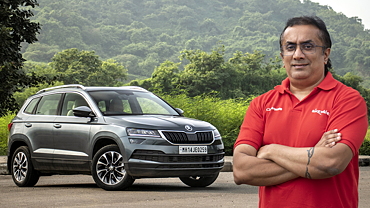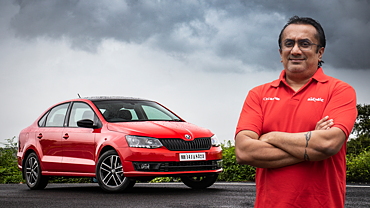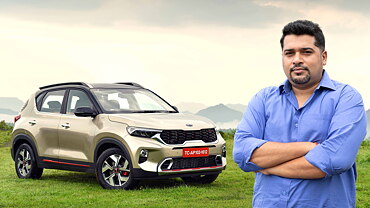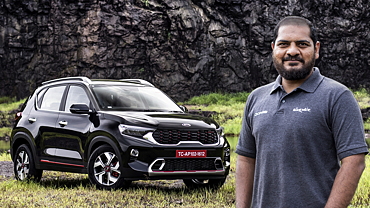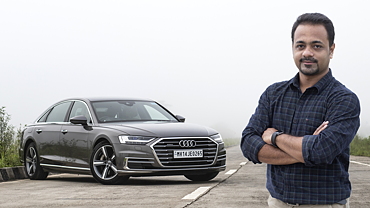
The Tata Hexa has been in the works for a considerable amount of time. It was first showcased at the 2016 Auto Expo, and the brand’s new flagship model serves as a replacement for the Aria. Though it shares the Aria’s platform, they’ve tweaked the styling broadly and equipped the car comprehensively to attract the young and style conscious buyer. It goes without saying that the first impression of this SUV is quite impressive, nonetheless. We drove the car extensively and this review will tell you whether the Hexa was worth the long wait.

There’s the unmistakeable Aria silhouette hidden away in the overall shape of the Hexa. But that’s just about it and designers have used their current design philosophy to bring about a dramatic and butch style with good road presence. We liked the front fascia with the angled head lamps which complement the sweeping bonnet and sharply raked air dams on the bumper.

Nevertheless, the sharp A-pillar with the quarter glass along with the D-pillar downward slant of the body coloured sheet metal could have been better executed. Indeed, the 19-inch steel-finish alloys do a good job of filling up those flared and cladded wheel arches. In contrast, it was rear portion of the Hexa that didn’t appeal; especially the boxy looks and the slabs of chrome between the tail lamps. However, the Hexa looks well put together and exhibits the kind of quality that’s expected in the segment.


The dashboard layout of the Hexa looks premium thanks to the new design additions and controls made of fresh-looking materials like chrome trim used with glossy black and soft grain plastic. The instrument cluster is easy to read and except for the low-set air-con controls, all functions are easily accessible on the dash.

We however noticed that the centre console was devoid of storage spaces barring the cup holder behind the gear shifter and the centre armrest. The seats are draped in a leather look-alike upholstery with contrast stitching that feels rich. In fact the front seats offer a comfortable drive thanks to the ample contours with lumbar, good back and appropriate thigh support.

Similarly, the middle row seats have identical contours and offer good support, headroom and lots of legroom for the occupants. Entry to the third row of seats is by tumbling the second row, and while the seats offer hardly any support, headroom and space for adults is also confined. With the last row up, the boot can only take a few soft bags and a thin suitcase at the most. To stuff anything more, the last row needs to be folded but it doesn’t fold flat either.


The Hexa equipment list consists of six airbags, ESP, traction control, ABS with EBD, climate control with vents on all three rows, auto headlamps, rain sensing wipers, and reverse parking sensors with a camera. There’s also power mirrors with demister, cruise control, rear sun blinds, an eight-way adjustable driver's seat (non-electric), a multi-function steering wheel, and a 5-inch touchscreen infotainment system with JBL speakers, to name a few.

It does miss out on features like powered seats and keyless go, which is a norm in the segment. There’s no sunroof either, which the rivals offer. In short, manual gearbox variants include XM and XT in six and seven seater options along with the choice of automatic transmissions called XMA and XTA. A 4x4 manual model is also available on the XT variant.


The Tata Hexa gets a 2.2-litre, four-cylinder diesel motor that’s available in two states of tune. A 150bhp five-speed manual gearbox version called Varicor 320, and a 156bhp Varicor 400 version that’s available with either a six-speed manual (4x4 optional) or a six-speed automatic gearbox. On paper, the Varicor 400 makes a healthy 400Nm of torque between 1,700rpm and 2,700rpm. Let’s start with the manual variant, and once off the mark, there is a considerable amount of lag till the turbo kicks in at about 2,000rpm.

Between 2,000rpm and 3,500rpm though, the motor pulls strongly and responds well to throttle inputs. Nonetheless, beyond 3,500rpm, despite the refinement levels going for a toss, the engine continues to pull steadily all the way to the 4,200rpm redline. We clocked the 0-100kmph run in 13.7sec, while the 20-80kmph and 40-100kmph runs were made in 12.46sec and 12.90sec. The notchy gearbox with a long throw made sure that shifting gears was far from convenient.
There are four driving modes in the manual version - Auto, Comfort, Dynamic and Rough Road. In Comfort and Dynamic modes, even though power is primarily sent to the rear wheels, it can power the front wheels if the need arises. Responses from the motor are more sedate in Comfort mode, and slants towards performance in Dynamic mode. Auto and Rough Road modes use full-time four-wheel drive, and while the former is used for road applications, the Rough Road mode is meant for off-road situations.
Let’s switch to the automatic version now. Surprisingly, none of the lag experienced in the lower rpms of manual version is felt here. The six-speed auto shifts smoothly at the appropriate rpms and covers up remarkably for the turbo lag too. It’s definitely the easier of the two to drive since the gearing is slightly shorter than on the manual which allows it to shift at an earlier rpm and stay in the meaty portion of the power band. Our VBox confirmed the 0-100kmph sprint is a second quicker than the manual at 12.67sec, and the 20-80kmph and 40-100kmph runs were swifter by 4.97sec and 3.17sec! It needs a mention too that the 90kg weight difference between the 4x4 manual and the 4x2 automatic works in favour of the latter.

The automatic version doesn’t have modes as such but gets three gear slot options - D, Sport and Manual. While ‘D’ makes sure that the gearbox shifts at the optimum rpm to save fuel, the Sport mode is brisker since the engine revs stay higher to provide instant response when necessary; but it shifts way before the redline. The manual mode, on the other hand, is the option to choose for superior performance, and it holds the gear all the way to the rev-limit.

The Aria’s chassis has been stiffened before applied to the Hexa, and this is evident from the minimal flex felt over our roads. The suspension comprising of a double wishbone and coil springs in the front, along with a five-link suspension with coil springs at the rear, is firm. At slow speeds the road unevenness filters into the cabin but thankfully there’s very little side-to-side movement. As speeds pick up, the ride quality is quite flat and this SUV is unfazed even when it goes over broken surfaces.

However, weighing in at between 2170kg and 2260kg (Auto/Manual), there’s no running away from the fact that the Hexa is heavy. And it shows in the way it rolls when pushed around a corner, but never to the point where it feels unpredictable. Plus, the 4x2 feels markedly lighter than the 4x4 due to the absence of the 4WD system. There's less weight at the axle too, which makes the steering lighter on the automatic 4x2 when compared to the 4x4 version. Overall, the Hexa’s steering is slightly heavy and vague off the dead centre, but makes changes in direction without much fuss.

The manual 4x4 Hexa is quite capable off-road due to the Rough Road mode that alters power delivery and makes the ESP less intrusive. The electronics are set up quite well and most of the time power is sent only to the rear wheels. It’s when the rear starts losing grip that the 4WD sends up to 40 per cent of the torque to the front wheels, even in on-the-road situations. Furthermore, under intense braking situations, the Hexa felt quite composed for an SUV of this size, and came to a standstill from 80kmph in 26m.

Prices for Tata’s Hexa starts at Rs 11.99 lakh (ex-showroom Delhi) for the manual XE model, all the way to Rs 17.49 lakh for the manual XT 4x4 variant. Automatic versions are priced between Rs 15.05 lakh and Rs 17.40 lakh for the XMA and XTA respectively. On the fuel economy front, while the manual version returned 9.4kmpl in the city and 13.8kmpl on the highway, the automatic returned 9.5kmpl and 13.2kmpl on the same cycles.
Final Rating: 3.79/5

Overall
If you look at the Hexa, the things that go against it is that it feels cumbersome when you're driving, and the lag at slow speeds in the manual gearbox version doesn’t help either. There are small details which really disappoint like the seats don’t fold flat, the lack of centre console storage spaces, and some features like keyless go, power seats and sunroof are missing. Plus, for those who have parking concerns then the length of this SUV (4.8m) could also pose as a challenge.
On the flip side, it has great road presence and also comes with a good combo of updated comfort features, safety equipment, and an effective automatic gearbox. While rivals like the Innova and XUV500 occupy the same space where the Hexa fits in, the Hexa looks like it is in a good position, both in terms of price and product, to take the fight head-on. A good effort from Tata.
Pictures: Kapil Angane
Tata Hexa First Drive Review
Tata Hexa vs Toyota Innova Crysta
Tata Hexa’s Drive Modes explained
| CAR NAME | Tata Hexa |
|
| Variant | XT 4x4 M/T VARICOR 400 | XTA 4x2 A/T VARICOR 400 |
| ENGINE | ||
| Fuel | Diesel | Diesel |
| Installation | Front, longitudinal | |
| Displacement | 4 cyls, 2179cc | 4 cyls, 2179cc |
| Bore/stroke | 85.0/96.0mm | 85.0/96.0mm |
| Valve gear | 4 valves per cyl, DOHC | 4 valves per cyl, DOHC |
| Power | 156bhp at 4000rpm | 156bhp at 4000rpm |
| Torque | 400nm at 1700-2700rpm | 400nm at 1700-2700rpm |
| Power to weight | 69bhp per tonne | 69bhp per tonne |
| Torque to weight | 176.99Nm per tonne | 176.99Nm per tonne |
| Gearbox | 6-speed manual | 6-speed automatic |
| CHASSIS & BODY | ||
| Construction | Ladder frame, five-door SUV | |
| Kerb weight | 2260kg | 2170kg |
| Tyres | 235/55 R19 | |
| Spare | Full size | |
| STEERING | ||
| Type | Rack and pinion, hydraulic | |
| Turning circle | 11.5m | |
| BRAKES | ||
| Front | Ventilated discs | |
| Rear | Discs | |
| Anti-lock | Yes | |
| PERFORMANCE & BRAKING |
Hexa XT 4x4 M/T Hexa XTA 4x2 A/T | |
| 0-20kph | 1.25s | 0.94s |
| 0-40kph | 3.16s | 2.67s |
| 0-60kph | 4.44s | 4.97s |
| 0-80kph | 5.72s | 8.30s |
| 0-100kph | 13.70s | 12.67s |
| 0-120kph | 20.04s | 18.70s |
| 20-80kph in kickdown*/3rd gear | 12.46s | 7.49s* |
| 40-100kph in kickdown*/4th gear | 12.90s | 9.73s* |
| 80-0kph | 26.01m 25.97m | |
| FUEL ECONOMY | ||
| City | 9.4kmpl | 9.5kmpl |
| Highway | 13.8kmpl | 13.2kmpl |
| Tank size | 60 litres | 60 litres |
| Range | 592km | 582km |
| INTERIOR MEASUREMENTS | ||
| Front | ||
| Legroom(Max/min) | 790/570mm | |
| Headroom(Max/min) | 1000mm | |
| Shoulder room | 1450mm | |
| Seat base length | 530mm | |
| Backrest height | 650mm | |
| Rear | ||
| 1m kneeroom | 790mm | |
| Kneeroom | 960/740mm | |
| Headroom | 990mm | |
| Shoulder room | 1460mm | |
| Seat base length | 520mm | |
| Backrest height | 600mm | |
| Boot | 544 litres (calculated) | |
| Depth/width/height | 1040/1190/440mm | |
